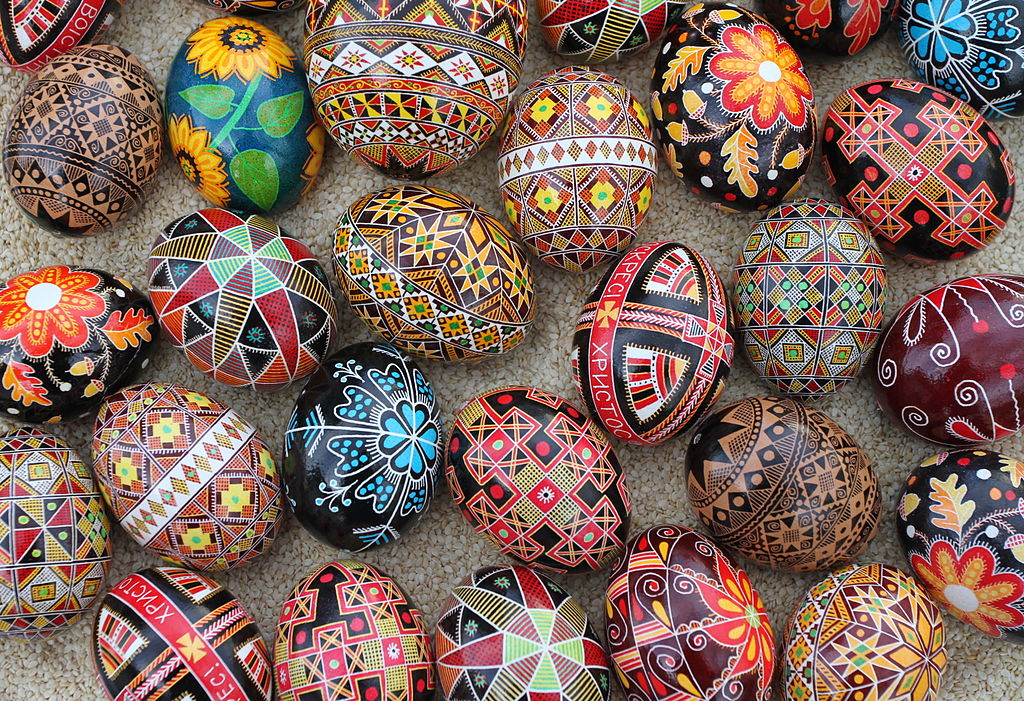
Juleigh Howard-Hobson
With their intricately wrought designs and deepset colors, Ukrainian Pysanky eggs are as fascinating as they are lovely. Pronounced “peh-san-keh”, these decorated eggs are considered Easter Eggs these days, and/or seen as examples of Eastern European folk art by collectors and tourists alike. But Pysanky (singular Pysanka) are far more numinous than that.
Pysanky have roots that stretch far back to Ancient European pagan spirituality. Indeed, traces of Trypillian symbology (Neolithic Era) can be still seen in many Pysanka designs.
Although best known, Ukraine is not unique in its indigenous European egg decorating. From the Polish pisanka, over to the Hungarian hímestojás, eggs have been decorated with dye and wax every spring since prehistoric times. For brevity sake, I’m going to refer to all of these by their Ukrainian name Pysanky.
There are other decorated eggs, but Pysanky created with dye and beeswax (it must be beeswax, due to sacred solar associations with bees and flowers) are special. Goose and duck eggs were once preferred, but hen eggs are used now. The egg must be raw, the designs ‘written’ with a “kistka”, a tool that holds flame-melted beeswax (flames bring sacred solar energy). The eggs are dyed and designs applied in succession until the Pysanka is finished. Then it is baked, to melt off the wax and set both the egg and the sacred intention it carries.
Traditionally, Pysanky are personal to the maker and to the recipients. Older people are given darker dyed eggs with a myriad of decoration, symbolizing their full lives, while younger people are given white eggs with spaces between decorations, representative of lives yet to be ‘filled in’.
Some carry a dual meaning since Christianity replaced the indigenous faith of the European peoples, but traditional Pysanka decorations are age-old. As in all artistic endeavors, there are as many designs as there are practitioners, but many meanings remain as they were since the Neolithic. Unbroken lines represent long life, crosses now represent Christ but once represented the sun (the solar cross), the spiral symbolize cycles of life/rebirth, ladders are bridges to the divine, deer symbolize victory, birds symbolize the eternal return of life (hens and roosters symbolize having many children). Triangles represented pagan triads (mother maiden crone, life-death-rebirth, etc.) but now represent the Holy Trinity. Wolves’ teeth, which look like jagged lines, bring loyal energies. Leaves and flowers (poppy and rose are most popular) stand for beauty and life-growth, wheat brings the recipient great abundance (harvest).
Having been given a Pysanka, one must never treat the gift lightly. The act of creating Pysanky is sacred — from the eternal symbol of life (the egg) to the time in which it is performed (spring, Ostara, Easter) to the flame and wax with which it is made to its transformation from raw to cooked—the making of each Pysanka is a magical rite from start to finish.
Most people have blown out eggs with Pysanka designs placed on them, these are not Pysanky, these are decoration, or folk art if you will. There is nothing to do with them but to admire what they represent of a folk’s yearning toward the divine.
If you should be gifted with an authentic Pysanka, you should admire it, but you should not save it. You should carry it about with you for the first couple of days of Easter/Ostara—or the day of and the day after the Spring Equinox. You can rinse a Pysanka in fresh water on the Equinox (or Easter) and rinse yourself with the same water to ritually cleanse yourself for the year. Pysanka shells can be thrown up on the roof to protect your household, or crushed and given to chickens to ensure fertility. Some Pysanka are left, whole, on graves of family members, especially children. Pysanka are never eaten.
Spring time is glorious, a swift bright time of creation and delight. The Pysanka, with its ancient designs and beautiful aspects, captures the holiness of this season as well. A numinous gift that has transcended the ages, renewed in spring, every year.

